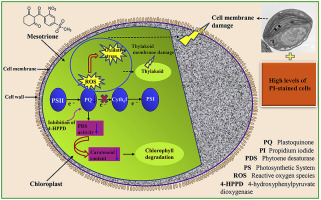当前位置:
X-MOL 学术
›
Chemosphere
›
论文详情
Our official English website, www.x-mol.net, welcomes your
feedback! (Note: you will need to create a separate account there.)
Effects of mesotrione on oxidative stress, subcellular structure, and membrane integrity in Chlorella vulgaris.
Chemosphere ( IF 8.1 ) Pub Date : 2019-12-27 , DOI: 10.1016/j.chemosphere.2019.125668 Fengwen Zhang 1 , Xiangfeng Yao 1 , Shiang Sun 1 , Lipeng Wang 1 , Weitang Liu 1 , Xingyin Jiang 1 , Jinxin Wang 1
Chemosphere ( IF 8.1 ) Pub Date : 2019-12-27 , DOI: 10.1016/j.chemosphere.2019.125668 Fengwen Zhang 1 , Xiangfeng Yao 1 , Shiang Sun 1 , Lipeng Wang 1 , Weitang Liu 1 , Xingyin Jiang 1 , Jinxin Wang 1
Affiliation

|
Mesotrione is a selective herbicide used to prevent weed attack of corn. It is extensively used, and hence, is being increasingly detected in aquatic ecosystems and may exert adverse effects on aquatic organisms. To evaluate the effects of mesotrione on photosynthesis-related gene expression, antioxidant enzyme activities, subcellular structure, and membrane integrity in algal cells, a comprehensive study was conducted using the green alga, Chlorella vulgaris. Exposure to 4-50 mg/L mesotrione resulted in a progressive inhibition of cell growth, with a 96-h median inhibition concentration (96 h- ErC50) value of 18.8 mg/L. Further, 18 and 37.5 mg/L mesotrione affected the algal photosynthetic capacity by decreasing the cell pigment content and reducing transcript abundance of photosynthesis-related genes. Mesotrione induced oxidative stress, as confirmed by increased cellular levels of reactive oxygen species (ROS) and malondialdehyde (MDA), and altered antioxidant enzyme activities. It also damaged the algal cellular structure, observed as plasmolysis, blurred organelle shape, and disruption of the chloroplast structure. Flow cytometry analysis revealed that mesotrione exposure led to uneven cell growth and interior irregularities in the algal cell. The apparent propidium iodide (PI) influx also confirmed that the herbicide induced damage of the cell membrane integrity. This study will facilitate the understanding of the physiological and morphological changes induced by mesotrione in C. vulgaris cells, and provide basic information for understanding the biological mechanisms of mesotrione-induced algal toxicity.
中文翻译:

甲基磺草酮对寻常小球藻的氧化应激,亚细胞结构和膜完整性的影响。
甲基磺草酮是一种选择性除草剂,用于预防玉米的杂草侵袭。它被广泛使用,因此在水生生态系统中越来越多地被检测到,并可能对水生生物产生不利影响。为了评估甲基磺草酮对藻类细胞中与光合作用相关的基因表达,抗氧化酶活性,亚细胞结构和膜完整性的影响,使用绿藻(Chlorella vulgaris)进行了全面研究。暴露于4-50 mg / L的甲基磺草酮导致细胞生长的逐步抑制,其96小时抑制浓度中值(96 h-ErC50)值为18.8 mg / L。此外,18和37.5 mg / L的甲基磺草酮会通过降低细胞色素含量和降低光合作用相关基因的转录本丰度来影响藻类的光合作用能力。甲基磺草酮引起的氧化应激 活性氧(ROS)和丙二醛(MDA)的细胞水平升高以及抗氧化酶活性的改变证实了这一点。它也破坏了藻类的细胞结构,表现为溶质,模糊的细胞器形状和叶绿体结构破坏。流式细胞仪分析显示甲基磺草酮暴露导致藻类细胞中细胞生长不均匀和内部不规则。明显的碘化丙啶(PI)涌入也证实了除草剂诱导了细胞膜完整性的破坏。这项研究将有助于了解寻常三聚氰胺在寻常梭状细胞中由甲基磺草酮诱导的生理和形态变化,并为了解甲基磺草酮诱导的藻类毒性的生物学机制提供基础信息。
更新日期:2019-12-27
中文翻译:

甲基磺草酮对寻常小球藻的氧化应激,亚细胞结构和膜完整性的影响。
甲基磺草酮是一种选择性除草剂,用于预防玉米的杂草侵袭。它被广泛使用,因此在水生生态系统中越来越多地被检测到,并可能对水生生物产生不利影响。为了评估甲基磺草酮对藻类细胞中与光合作用相关的基因表达,抗氧化酶活性,亚细胞结构和膜完整性的影响,使用绿藻(Chlorella vulgaris)进行了全面研究。暴露于4-50 mg / L的甲基磺草酮导致细胞生长的逐步抑制,其96小时抑制浓度中值(96 h-ErC50)值为18.8 mg / L。此外,18和37.5 mg / L的甲基磺草酮会通过降低细胞色素含量和降低光合作用相关基因的转录本丰度来影响藻类的光合作用能力。甲基磺草酮引起的氧化应激 活性氧(ROS)和丙二醛(MDA)的细胞水平升高以及抗氧化酶活性的改变证实了这一点。它也破坏了藻类的细胞结构,表现为溶质,模糊的细胞器形状和叶绿体结构破坏。流式细胞仪分析显示甲基磺草酮暴露导致藻类细胞中细胞生长不均匀和内部不规则。明显的碘化丙啶(PI)涌入也证实了除草剂诱导了细胞膜完整性的破坏。这项研究将有助于了解寻常三聚氰胺在寻常梭状细胞中由甲基磺草酮诱导的生理和形态变化,并为了解甲基磺草酮诱导的藻类毒性的生物学机制提供基础信息。






























 京公网安备 11010802027423号
京公网安备 11010802027423号